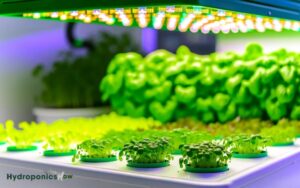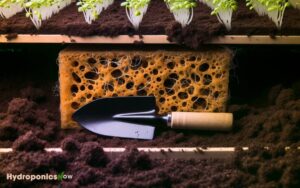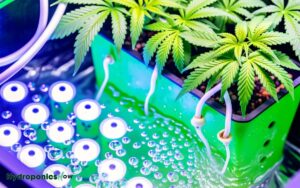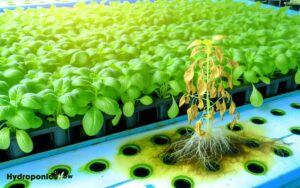Foliar Feeding 101: You Using Regular Hydroponic Nutrient Solution for Plants
Yes, you can foliar feed plants using regular hydroponic nutrient solution. Foliar feeding allows for rapid nutrient uptake through the stomata and cuticle of leaves, enhancing photosynthesis and addressing specific deficiencies swiftly.
It is essential to adjust the concentration of the hydroponic solution to prevent phytotoxicity, maintain the pH between 5.5-6.5, and apply during ideal times like early morning or late evening.
Proper calibration and timing guarantee minimal risk of leaf burn and maximize nutrient absorption efficiency.
By tailoring nutrient formulations and application techniques, foliar feeding can greatly boost plant health and productivity. Further guidance on best practices follows.

Key Takeaways
Understanding Foliar Feeding
Foliar feeding, a technique frequently employed in horticulture, involves the direct application of nutrient solutions to the leaves of plants for rapid nutrient absorption and immediate physiological benefits.
This method leverages the plant’s stomata and cuticle, facilitating the uptake of essential nutrients, bypassing the root system.
When preparing nutrient solutions for foliar feeding, the concentration must be carefully calibrated to prevent phytotoxicity. Dilution ratios often differ from root-based applications due to the leaf’s different absorption dynamics.
The pH level of the solution should ideally range between 5.5 and 6.5 to enhance nutrient availability.
Application timing is vital; early morning or late afternoon is best to minimize evaporation and maximize stomatal uptake. Proper spraying techniques ensure uniform coverage, critical for effectiveness.
Benefits of Foliar Feeding
The primary advantage of foliar feeding lies in its ability to provide rapid nutrient delivery directly to the plant’s foliage, resulting in faster correction of nutrient deficiencies and enhanced growth.
This method allows for immediate nutrient uptake, bypassing the root system and soil interactions that might limit nutrient availability.
Benefits include:
- Swift Nutrient Absorption: Foliar feeding guarantees swift assimilation of essential minerals, often within hours.
- Enhanced Photosynthesis: Direct application of nutrients can boost chlorophyll production, improving photosynthetic efficiency.
- Stress Mitigation: Foliar feeding can alleviate plant stress caused by adverse soil conditions or environmental factors.
- Targeted Nutrition: It allows for precise application, addressing specific deficiencies without altering the overall soil or hydroponic nutrient balance.
This approach optimally supports plant health and productivity.
How Plants Absorb Nutrients
Plants absorb nutrients through their leaf surfaces via a process that involves both passive and active transport mechanisms.
The stomata play an essential role by regulating the uptake of essential nutrients dissolved in the hydroponic nutrient solution.
Understanding this nutrient uptake mechanism is important for optimizing foliar feeding practices and ensuring efficient nutrient assimilation.
Leaf Surface Absorption
Leaf surface absorption occurs when plants uptake nutrients directly through their leaves, bypassing the root system and allowing for more immediate nutrient availability. This process is facilitated by the cuticle and stomata, specialized structures on leaf surfaces.
To optimize foliar feeding, consider the following:
- Nutrient Concentration: Use a diluted hydroponic nutrient solution to prevent leaf burn and guarantee efficient nutrient uptake.
- Application Timing: Apply during cooler parts of the day, such as early morning or late afternoon, to minimize evaporation and maximize absorption.
- pH Balance: Maintain a pH range of 5.5-6.5 to enhance nutrient solubility and uptake efficiency.
- Spray Coverage: Ensure even application across the leaf surface to provide uniform nutrient distribution.
This approach leverages leaf anatomy for effective nutrient delivery.
Nutrient Uptake Mechanism
Understanding the nutrient uptake mechanism in plants involves examining the complex interplay between various physiological processes and cellular structures.
Plant roots primarily absorb nutrients through active transport and diffusion across the root cell membranes. Active transport requires energy in the form of ATP to move ions against their concentration gradient via specific transporter proteins.
Meanwhile, diffusion allows passive movement of nutrients along the gradient.
In foliar feeding, the absorption of nutrients occurs through the leaf cuticle a hydrophobic layer and subsequent movement into the mesophyll cells. This process can be enhanced by surfactants that reduce surface tension, facilitating nutrient penetration.
Effective foliar feeding requires careful consideration of nutrient concentrations to avoid phytotoxicity and promote optimal plant health and growth.
Stomata and Nutrients
In addition to root and cuticle absorption, stomata play a crucial role in nutrient uptake by facilitating the entry of essential elements directly into the plant’s internal tissues.
These microscopic pores, mainly located on the underside of leaves, regulate gas exchange and transpiration, thereby offering an additional pathway for nutrient absorption.
When applying foliar feeds, consider the following:
- Timing: Apply during early morning or late afternoon to minimize evaporation and maximize stomatal opening.
- Concentration: Use diluted hydroponic solutions to prevent leaf burn and guarantee nutrient assimilation.
- pH Levels: Maintain a foliar spray pH between 5.5 and 6.5 to enhance nutrient uptake.
- Surfactants: Incorporate surfactants to improve solution adhesion and spread across the leaf surface.
Understanding these factors optimizes foliar feeding efficacy.
Hydroponic Nutrient Solutions
Hydroponic nutrient solutions are meticulously formulated to guarantee essential macro and micronutrients directly reach plant roots, optimizing growth and productivity.
These solutions are water-based and contain a precise mixture of elements such as nitrogen, phosphorus, potassium, calcium, magnesium, and trace elements like iron, manganese, and zinc.
The nutrient concentrations are calibrated to meet the specific needs of plants at various growth stages, ensuring balanced nutrient uptake and preventing deficiencies.
The solubility of these nutrients facilitates their rapid absorption, enhancing metabolic processes and promoting robust plant health.
When considering foliar feeding, the formulation’s concentration and pH must be adjusted to avoid leaf burn and secure efficient nutrient uptake through the stomata, the microscopic pores on leaf surfaces.
Key Components of Nutrient Solutions
A thorough understanding of the key components in nutrient solutions is crucial for optimizing plant health and growth in hydroponic systems.
Essential nutrient elements, including both macronutrients like nitrogen, phosphorus, and potassium, and micronutrients such as iron, manganese, and zinc, must be precisely balanced.
The composition of the nutrient solution directly impacts plant uptake efficiency, making accurate formulation and monitoring imperative for successful foliar feeding.
Essential Nutrient Elements
Understanding the essential nutrient elements in hydroponic nutrient solutions is important for optimizing plant health and growth. These nutrients include macronutrients like nitrogen, phosphorus, and potassium, as well as essential micronutrients such as iron and magnesium. Proper nutrient balance is crucial, as deficiencies or excesses can negatively impact plant development. Utilizing hydroponic pH chart insights helps growers maintain optimal pH levels, ensuring nutrient availability and efficient plant uptake.
These elements are divided into macro and micronutrients, each playing a significant role in plant development. Key macronutrients include nitrogen (N), phosphorus (P), and potassium (K), essential for overall growth, energy transfer, and metabolic processes.
Micronutrients, although required in smaller amounts, are equally essential. Here are the primary categories:
- Macronutrients: Including nitrogen, phosphorus, potassium, calcium, magnesium, and sulfur.
- Micronutrients: Comprising iron, manganese, zinc, copper, molybdenum, boron, and chlorine.
- Secondary Nutrients: Such as calcium, magnesium, and sulfur, often grouped with macronutrients.
- Beneficial Elements: Silicon, cobalt, and nickel, which can enhance growth under specific conditions.
Proper management of these nutrients ensures excellent plant health and productivity.
Nutrient Solution Composition
The composition of nutrient solutions in hydroponic systems is meticulously balanced to provide plants with the precise ratios of essential macro and micronutrients necessary for ideal growth and development.
Key macronutrients include nitrogen (N), phosphorus (P), and potassium (K), often referred to collectively as NPK. These are critical for vegetative growth, root development, and overall plant health.
Additionally, secondary macronutrients such as calcium (Ca), magnesium (Mg), and sulfur (S) play significant roles in enzyme activation and chlorophyll production.
Micronutrients like iron (Fe), manganese (Mn), zinc (Zn), copper (Cu), molybdenum (Mo), and boron (B) are essential in trace amounts for physiological processes.
Achieving the correct balance of these elements is necessary for nutrient uptake efficiency and minimizing deficiencies.
Compatibility With Foliar Feeding
Compatibility with foliar feeding hinges on the nutrient solution’s concentration, pH level, and the plant’s specific absorption capabilities.
To optimize foliar feeding using a hydroponic nutrient solution, the following factors must be meticulously considered:
- Concentration: Dilute the nutrient solution to an appropriate level to prevent leaf burn and maximize nutrient uptake.
- pH Level: Maintain a pH range of 5.5 to 6.5 for best absorption through the leaf stomata.
- Absorption Capabilities: Understand each plant species’ unique ability to absorb nutrients through foliar application, as this varies widely.
- Solution Composition: Ensure the solution contains essential micronutrients like iron, manganese, and zinc, which are more effectively absorbed foliarly.
Adhering to these parameters guarantees the hydroponic nutrient solution is compatible with foliar feeding, enhancing overall plant health and growth.
Preparing the Nutrient Mix
Properly preparing the nutrient mix for foliar feeding necessitates precise measurements and adherence to established guidelines to guarantee ideal nutrient availability and plant health.
Begin by selecting a high-quality hydroponic nutrient solution with a balanced formulation suitable for foliar application.
Make sure the solution contains essential macronutrients (N, P, K) and micronutrients (Fe, Mn, Zn, Cu, B, Mo). Dissolve the nutrients in distilled or deionized water to prevent mineral interference. Utilize a calibrated digital scale for exact nutrient measurements.
Employ a clean, non-reactive container to mix the solution, ensuring all components are fully dissolved. Consistently monitor pH levels, adjusting to a recommended range of 5.5-6.5 for maximal nutrient uptake and leaf absorption efficiency.
Proper Dilution Ratios
Accurately determining the proper dilution ratios is crucial for optimizing the efficacy of foliar feeding with hydroponic nutrient solutions.
Appropriate dilution guarantees that nutrients are effectively absorbed without causing phytotoxicity or nutrient burn. Factors to take into account include the plant species, growth stage, and specific nutrient requirements.
Generally, hydroponic nutrient solutions should be diluted to approximately 25% of their standard concentration for foliar application.
Here are key steps to follow:
- Calculate Desired Concentration: Determine the appropriate concentration based on plant needs.
- Measure Nutrient Solution: Carefully measure the hydroponic solution using precise instruments.
- Dilute with Water: Mix the measured solution with water to achieve the desired dilution ratio.
- Verify pH Levels: Ensure the final solution maintains an ideal pH range (typically 5.5 to 6.5).
These steps facilitate effective foliar feeding, enhancing plant health and growth.
Application Techniques
To optimize foliar feeding, employing the spray bottle method guarantees even distribution of the hydroponic nutrient solution across leaf surfaces.
It is essential to maintain accurate nutrient dilution ratios to prevent phytotoxicity and promote efficient nutrient uptake.
Regular calibration of the spray bottle and adherence to recommended application frequencies will enhance plant health and growth.
Spray Bottle Method
Utilizing a spray bottle for foliar feeding involves atomizing the hydroponic nutrient solution to guarantee even coverage on the plant leaves, facilitating efficient nutrient absorption. This method is particularly effective when executed correctly.
Here are essential points to keep in mind:
- Nozzle Selection: Choose a spray bottle with an adjustable nozzle to achieve a fine mist, ensuring ideal droplet size for leaf absorption.
- Application Timing: Conduct foliar feeding during early morning or late evening to minimize evaporation rates and improve nutrient uptake.
- Spray Technique: Aim for uniform distribution by spraying both the upper and lower leaf surfaces, which maximizes the contact area for nutrient absorption.
- Frequency: Regular application, typically once a week, guarantees continuous nutrient availability without overwhelming the plant’s physiological processes.
Nutrient Dilution Ratios
Understanding the appropriate nutrient dilution ratios is essential to optimizing foliar feeding efficacy and preventing potential phytotoxicity.
When using hydroponic nutrient solutions for foliar applications, it is important to dilute the solution significantly typically to a concentration of 25% or less of the standard root-feeding strength.
This guarantees that nutrient uptake is efficient without causing leaf burn or other damage.
Employing a precise measurement tool, such as a calibrated pipette or graduated cylinder, is recommended for accuracy. Additionally, maintaining a pH range between 5.8 and 6.2 enhances nutrient absorption through the stomata.
Regularly monitoring plant response and adjusting the dilution ratio accordingly will help achieve the best results.
This method maximizes nutrient utilization while safeguarding plant health.
Timing and Frequency
Finding the best timing and frequency for foliar feeding with hydroponic nutrient solutions is essential for maximizing plant health and growth efficiency. Proper scheduling can greatly enhance nutrient uptake and foliar health.
Here are essential guidelines:
- Morning Application: Apply foliar nutrients in the early morning when stomata are open, allowing ideal nutrient absorption.
- Weekly Frequency: For most plants, once a week is sufficient. Over-frequent applications can lead to nutrient imbalances and leaf burn.
- Growth Stage Consideration: Young plants benefit more from foliar feeding than mature ones, particularly during vegetative growth phases.
- Environmental Conditions: Avoid foliar feeding during high temperatures or intense sunlight to prevent nutrient solution evaporation and leaf damage.
Implementing these practices ensures effective nutrient delivery and promotes robust plant development.
Potential Risks and Precautions
Several important risks and precautions must be taken into account when foliar feeding plants with hydroponic nutrient solutions to safeguard plant health and prevent damage.
Over-concentration of nutrients can lead to phytotoxicity, characterized by leaf burn or necrosis. It is vital to dilute the solution appropriately, often to one-quarter of the root-feeding concentration.
Additionally, foliar feeding should be conducted during cooler times of the day, such as early morning or late afternoon, to minimize evaporation and maximize absorption. Protective gear, including gloves and goggles, is recommended to avoid skin and eye irritation.
Furthermore, regular monitoring for any adverse reactions, such as discoloration or wilting, is essential to promptly adjust the nutrient formulation and application frequency.
Signs of Overfeeding
Overfeeding during foliar application manifests through symptoms such as chlorosis, leaf scorching, and stunted growth, indicating nutrient toxicity. Recognizing these signs promptly is essential for mitigating potential damage.
Key indicators of overfeeding include:
- Chlorosis: Yellowing of leaves due to impaired chlorophyll production, often starting at the leaf margins and progressing inward.
- Leaf Scorching: Brown, burnt-like edges on leaves, caused by excessive nutrient concentration leading to cellular damage.
- Stunted Growth: Reduced plant development and smaller leaves, resulting from nutrient imbalances that disrupt metabolic processes.
- Nutrient Crystallization: Visible salt deposits on leaf surfaces, indicating over-application and reduced nutrient uptake efficiency.
Monitoring these symptoms allows growers to adjust nutrient concentrations and application frequencies, ensuring optimal plant health and growth.
Optimizing Plant Health
To optimize plant health during foliar feeding with hydroponic nutrient solutions, it is important to fine-tune nutrient concentrations and application schedules based on plant species and growth stages. Different plants have varying nutrient uptake rates and requirements.
For instance, nitrogen needs are higher during vegetative growth, while phosphorus becomes essential during flowering. Utilize a dilute nutrient solution, typically around 0.1%-0.2% concentration, to prevent leaf burn and guarantee efficient absorption.
Apply foliar feeds during cooler parts of the day, such as early morning or late afternoon, to minimize evaporation and maximize uptake. Regularly monitor leaf health and adjust nutrient formulations accordingly.
Employing a balanced approach will enhance photosynthetic efficiency, bolster plant resilience, and promote robust growth.
Conclusion
Foliar feeding, utilizing hydroponic nutrient solutions, offers a viable method for direct nutrient absorption through plant leaves. According to research, foliar feeding can increase nutrient uptake efficiency by up to 95%, compared to traditional soil methods.
However, careful attention must be paid to the composition of the nutrient solution, application timing, and frequency to prevent potential phytotoxicity.
Understanding these parameters is essential for optimizing plant health and maximizing agricultural productivity through this advanced feeding technique.






